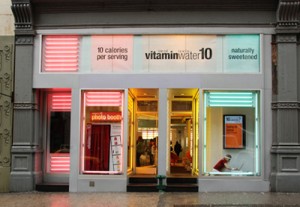Come and get it…but hurry. You’ve only got 96 hours before this limited edition retail experience moves out of town. Hurry up! You don’t want to miss out.
Pop-up stores—retail outlets that open temporarily and then move on—are sprouting up around the US (and abroad) as a new way to engage customers and market products. From online retailers (like eBay and piperlime.com) to car manufacturers to tourism bureaus, pop-up stores allow companies to generate buzz and create a custom consumer experience.
1. One-to-One Marketing
Pop-up stores create a one-to-one marketing experience by allowing consumers to engage with (see, touch, smell) products and speak directly to retailers. For example, the Greater Fort Lauderdale Convention & Visitors Bureau opened a pop-up location in New York in January. They created the entire sensory experience for shoppers—a beach (complete with sand), a putting green and lifeguards. Consumers stepped out of the snow and into paradise.
2. Testing Grounds
Pop-up stores are an excellent opportunity for various types of retailers to introduce their products to the public. Online retailers can give customers the opportunity to engage with their products for the first time. Additionally, pop-up stores allow companies to test new products or market areas with no long-term commitment. Finally, many companies use pop-up stores to launch new products—giving dedicated customers the “first look.”
3. Media Attention
The sense of urgency that surrounds pop-up stores helps them generate a huge amount of buzz. For example, the U.S. Potato Board opened a pop-up store in New York to promote potatoes as a good source of potassium and vitamin C. The store got them featured in the New York Times and a number of network morning shows—which would have been impossible using traditional marketing tactics within the same budget.
4. Cost
Pop-up stores are efficient for retailers and landlords. The cost of opening a pop-up store is far less than the cost of producing television ads and buying television time. Additionally, since the investment in relatively low, marketers can be more progressive and think “outside the box.” Japanese clothing brand Uniqlo, promoted their launch in New York by opening a pop-up store in a shipping container. The idea—that the products were literally coming to New York from Tokyo—sent a clear message at a relatively low cost. For landlords, pop-up stores are a way to generate income in otherwise unoccupied properties and keep activity in the neighborhood alive.
Pop-up stores are not limited to one type of retailer. Companies like Nike, Gap, JVC, Wal-Mart, eBay, VitaminWater, Lexus and Ford have already entered the pop-up space. In time, we can expect to see pop-ups going places other than New York and Los Angeles, which have emerged as far and away the most popular locations. Big cities are attractive for a variety of reasons (number of inhabitants and major media outlets top the list), but pop-up stores will also emerge in more rural areas, giving those shoppers the opportunity to purchase products not usually available to them.
Sources:
Advertising Age: http://adage.com/article?article_id=138704
Businessweek: http://www.businessweek.com/bwdaily/dnflash/content/feb2007/db20070206_949107.htm
New York Magazine: http://nymag.com/daily/fashion/2010/09/first_look_inside_the_piperlim.html



5 Responses to Pop-Up Stores Flourishing as New Trend in Consumer Marketing